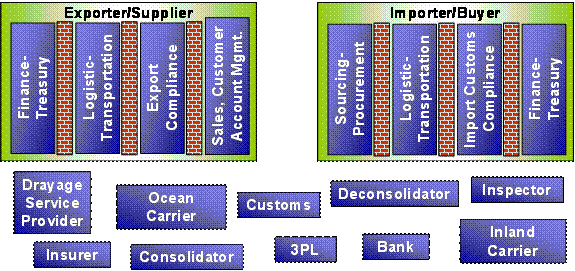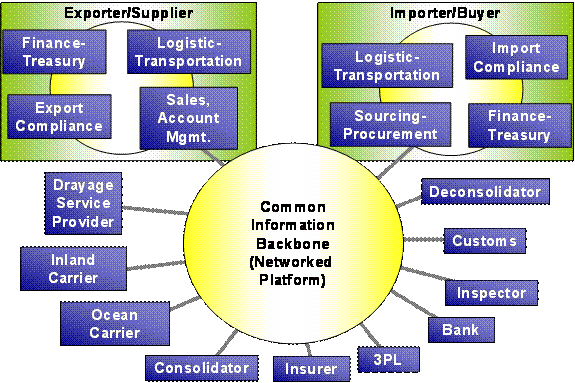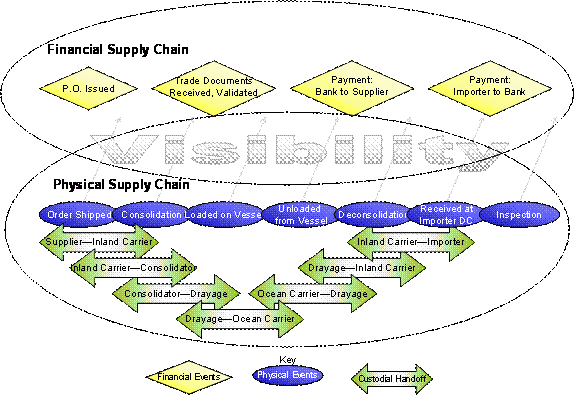Convergence
In the world of global trade, the physical, financial, and information networks are becoming increasingly intertwined. Traditionally, these disciplines have not understood each other’s realms to any significant depth. When supply chains were shorter and more domestic, and more work was done inside the enterprise, companies could get away with limited integration between finance and supply chain. (See Figure 1)

Figure 1 - Silo'd Global Trade Management
Now that supply chains are global, lead times elongated, and supply chain costs up, these functions can no longer exist independently. Financial—Supply Chain convergence requires that supply chain personnel and financial personnel start working more closely. Supply chain and finance people have to learn how to speak each other’s language. The CFO needs to learn what an ASN is. The VP of Supply Chain needs to learn about working capital management. Payment processes must be integrated with inventory and logistics processes.
(See Figure 2)

Figure 2 - Integrated Global Trade Management
Without this integration, processes will be dramatically sub-optimized, with substantial untapped value left on the table. This was OK in the old domestic/vertical scenario, but it really hurts in the new globalized world.
|
Financial Network |
Physical Network |
Information Network |
Players |
Importer, Exporter, banks, insurance companies |
Importer, Exporter, carriers, 3PL, inspectors, customs |
All Financial and Physical players + platform provider |
Topology |
Nodes and links defined by financial relationships, with banks as the hubs |
Nodes and links defined by physical infrastructure—e.g. plants, warehouses, roads, ports, rail lines, airports, etc. |
Direct connectivity of all players, with network platform as the hub |
Processes and Events |
Commitments (contracts, orders), validation and reconciliation, payment |
Physical movements, handoffs, inspections and verification |
Entry, validation, and consolidation of data, workflow, generate alerts |
Table 1 - Financial, Physical, Information Network Attributes
New Financial Models Evolving
As globalization of trade matures, the financial relationships are evolving as well. Some of the tried and true financial instruments of the past, such as Letter of Credit (LC), are giving way to more immediate straightforward processes, in particular, payment on Open Account (OA). LCs are useful during the initial push to overseas, when suppliers and buyers are not well known to each other. But they are quite expensive and tie up lines of credit for importers. As importers and exporters do business more and relationships mature, the risks of non-payment and non-performance diminish, and importers are able to push trade payments off of LC and onto OA[1]. This shift away from Letters of Credit is requiring everyone to readjust because:
-
Banks made fees on LCs
-
Importers used them to mitigate performance risk, ensuring that the exporter/supplier performed to the contract
-
Suppliers relied on them to secure pre-shipment financing, get paid sooner, and mitigate credit risk.
Exporters lose a source of financing under Open Account, because they could borrow against the LC they had before. To fulfill this now unmet need, import banks are stepping in and playing an increasingly important role, broadening their offerings to provide export financing which helps to create liquidity in the supply chain. This can be either pre-export financing (paying the supplier before goods are received) or post-export financing (payment after goods received). To manage their risk of providing this upfront liquidity, the import bank requires a detailed and reliable understanding of:
-
Importer’s credit-worthiness and payment track record— the bank often already has a good picture of this, since the importer is a client of the bank.
-
Exporter’s supply chain performance track record (on-time, quality, etc.)— this is especially important if the bank is providing pre-export financing.
With LCs, banks implicitly managed the import AP process for the importer. In effect, the importer outsourced this function to the bank, and in many cases no longer has the in-house operational capabilities required to track the events, validate the trade documents, and determine when to make a payment. Therefore, many importers want their bank to continue providing document examination and reconciliation services. In fact, some banks are broadening their capabilities to offer a wider set of services, managing the whole purchase order to payment cycle. These changes in financial models have major implications for the technology platforms used to manage the financial and physical supply chains.
New Technology required
In the 1990s, ERP emerged as a way to unify systems within an enterprise, replacing and/or augmenting fragmented legacy and departmental systems. More recently, with more and more being done outside the four walls of the enterprise and so many more players involved, we see the emergence of platforms that sit on the network between companies. These network-based platforms help to coordinate and communicate, providing a Single Version of the Truth (SVoT) amongst all the players[2].
Networked platforms for supply chain tracking are particularly relevant in dealing with the financial supply chain changes mentioned above. Open account arrangements have a lot fewer rules than LCs. LCs are governed by a set of codes called the Uniform Customs and Practice (UCP600 is the current version), which has matured and been refined over many decades. With the LC, if something goes wrong, the parties have rules to fall back on. OA payments have no equivalent set of governing codes or customary practices, so there is a greater need to manage risk.
To mitigate risk, all the players want visibility to see that everything is executing to plan, providing an early warning system if things are late or going astray. This visibility comes in part from electronic documentation of physical movement (such as cargo receipts and Bill of Lading) to track each stage—carrier took possession at factory, loaded at vessel, offloaded, arrived at the destination DC, etc. (See Figure 3)

Figure 3 - Visibility between Physical and Financial Supply Chains
The network platform provides this visibility and integration between the physical and financial supply chains. This visibility creates more predictability in supply chain events, reducing the risks in financing the flow of goods. Banks are able to charge less when the risk is lower. The network platform is especially valuable to banks in two critical roles that they play in the new OA world:
- Managing Importers’ Payables
With OA, banks are not as tied to paper documents as they were with LCs. So, they would like to streamline and automate processes. Having the suppliers, carriers, and all the key players tied together on a networked platform using electronic trade documentation reduces errors, provides visibility at each step, and speeds the process tremendously; compared with shipping paper documents via courier all around the world. For participants in emerging economies, who often have less sophisticated IT infrastructures, document creation and presentment can be done on the platform using just a web browser.
- Providing Liquidity Across the Supply Chain
When banks can see confidently and quickly what’s going on, they are more willing to provide pre-export and post-export financing. A bank providing pre-export financing has a very strong interest in knowing, at the earliest point, whether a shipment went out on time or was delayed. Banks and other financial organizations that finance in-transit inventory can offer more attractive rates when their risk is reduced through better visibility.
Ultimately, the pre-export and post-export finance and payment processes should be automated as continuous processes, rather than as a series of one-off discrete decisions. Automation of the release of funds to the exporter, and receiving payment back on that invoice from the importer, are all driven off what is happening on the physical supply chain. That automation and efficiency can be achieved when the systems of the multiple companies involved are integrated onto one platform, as if they were a single virtual company.
Opportunities – Looking Ahead
As financial and physical supply chains integrate more tightly, it opens up opportunities for all the players. When banks and other financial organizations have reliable and comprehensive scorecards of suppliers’ past performance and complete visibility into events as they unfold in the supply chain, they have the ability to offer a much broader pallet of services, and provide earlier and deeper financing, creating liquidity in the supply chain. In addition to the new revenue it creates for these financial institutions, it improves cash flow for suppliers, enabling them to invest in expansion of their business. Earlier and deeper financing lowers supplier cost of capital; those savings can be shared by the various players across the supply chain and/or ultimately translate into lower-priced (more competitive) products for the end consumer. These benefits can only be fully realized when there is tight integration between the financial and physical supply chains, enabled by a networked application platform.
[1] With an open account, the exporter simply bills the importer, who is expected to pay under agreed terms at a future date.
[2] Networked application platforms have the advantage that the effort to integrate each new trading partner onto the platform is leveraged across all the partners on the platform; in contrast to private trading hubs where the burden of integrating each new trading partner falls on the one company operating the hub, and is not leverageable across a wider community.
















